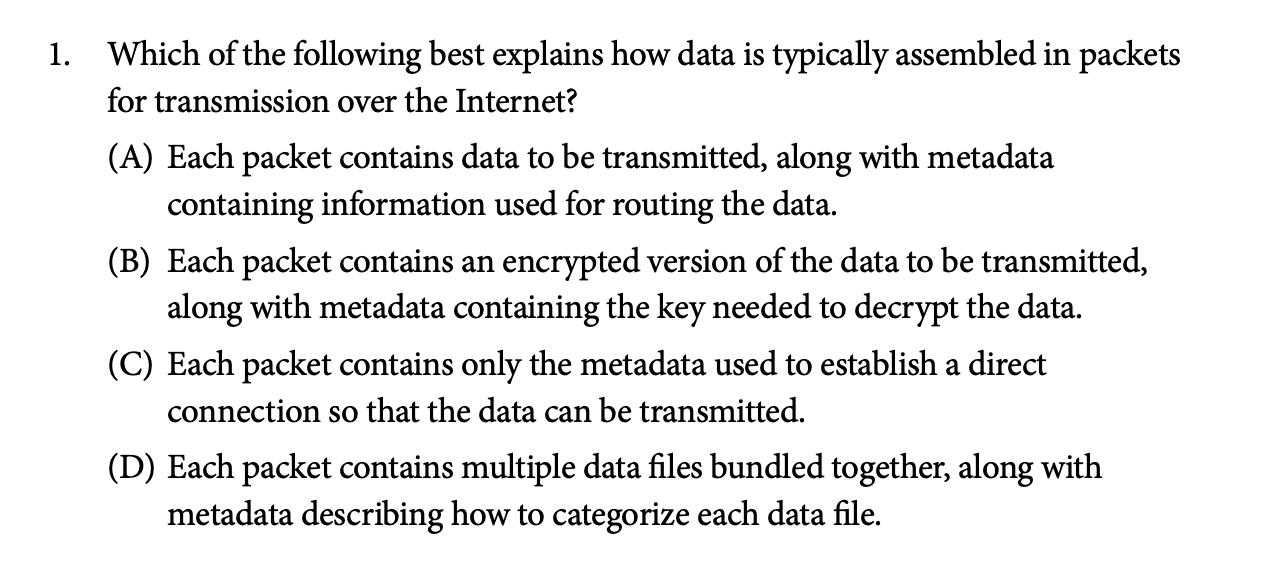Big Idea 4 Overview: Computer Systems and Networks
4 min read•june 18, 2024
Minna Chow
AP Computer Science Principles ⌨️
80 resourcesSee Units
This guide was based on the updated 2020-21 Course Exam Description. The Learning Objectives are taken directly from the CED's learning objectives.
The One Thing You Need to Know About this Big Idea:
This Big Idea focuses on computer systems and networks: what they are, how they work, and how they can be used to help you speed up your programs. One of the biggest connectors of computer systems is the Internet, and a great deal of this guide also covers how the internet works.
Exam Weighing:
- 11-15% of the AP Exam
- This translates to about 10 questions on the multiple-choice test.
- This Big Idea won't be tested in your Create Project.
4.1 The Internet
Learning Objective: Explain how computing devices work together in a network.
Learning Objective: Explain how the Internet works.
Learning Objective: Explain how data are sent through the Internet via packets.
Learning Objective: Describe the differences between the Internet and the World Wide Web.
Study Tip: In this unit, you'll not only need to know the definitions of key terms but also be able to answer the "explain" questions above.
Key Ideas
- compare computing device vs computing system vs computer network
- what is routing? how does it work?
- what bandwidth is and how it is measured
- how does the internet work?
- how do devices connect to each other on it?
- how is data sent through it?
- what are protocols and how do they work?
- what is scalability and why is it important?
- explain data streams and packets
- be able to identify common protocols
- compare the world wide web to the internet: the two are not the same!
Vocabulary
- computing device
- computing system
- computer network
- bandwidth
- internet
- protocols
- scalability
- server
- router
- sender
- receiver
- routing
- data streams
- packets
- world wide web
Resources
4.2 Fault Tolerance
For fault-tolerant systems, like the Internet: a. Describe the benefits of fault tolerance; b. Explain how a given system is fault-tolerant; c. Identify vulnerabilities to failure in a system.
Study Tip: This unit revolves around the concept of fault-tolerance: understand that term and you're good to go.
Key Ideas
- definition of fault-tolerant
- examples of fault-tolerant systems
- the internet is fault-tolerant: why is that?
- what is redundancy and how do we build it into our systems?
- vulnerabilities to failure in a system
- benefits of fault-tolerance
Vocabulary
- fault-tolerant
- redundancy
- Distributed Denial of Service Attack (DDoS)
4.3 Parallel and Distributed Computing
For sequential, parallel, and distributed computing: a. Compare problem solutions; b. Determine the efficiency of solutions.
Study Tip: Compared to the rest of Big Idea 4, this unit is the one that requires the most math. You'll need to do some basic addition to calculate the time it takes solutions to complete, and long division to calculate the speedup. Doing example problems will be super helpful!
Key Ideas
- compare Sequential computing vs Parallel computing vs Distributed computing
- calculate the time it takes to complete a solution
- compare the efficiency of solutions (calculate the speedup)
- explain the benefits of parallel computing
- explain the benefits of distributed computing
- explain the challenges of parallel and distributed computing
Vocabulary
- Sequential computing
- Parallel computing
- Distributed computing
- speedup
🔗 4.3 Parallel and Distributed Computing - contains two example problems!
Example Problem
This problem is taken from page 172 of the CED.

Answer
The answer is A. This problem tests your knowledge of how data streams and packets work. It's a tricky question because three out of four answers get the basics right. Packets do contain both data and metadata. (This means we can eliminate answer C.) One way to approach this question is to look at the description of the metadata.
Does the metadata contain…
- routing information?
- a decryption key?
- categorization information?
When data is sent over the internet in packets, it will always include routing information. Therefore, the answer is A.
Study Tip: This question is one of three types of problems you'll see on this unit.
- Definition Problems ask you a question based on your knowledge of a term's definition.
- Explanation Problems ask you a question based on your knowledge of how a concept works (ex: routing, the Internet.)
- Computing Solution Problems ask you to calculate something about a Sequential computing or Parallel computing solution — either the time it takes the solution to complete, the speedup, or both.
The above problem is an example of Type 2: Explanation Problems.
You might see these questions tacked on to the end of a reading passage, which will ask you to answer questions based on a hypothetical scenario.
Browse Study Guides By Unit
🕹Unit 1 – Creative Development
⚙️Unit 2 – Data
📱Unit 3 – Algorithms & Programming
🖥Unit 4 – Computer Systems & Networks
⌨️Unit 5 – Impact of Computing
🧐Exam Skills

Fiveable
Resources
© 2025 Fiveable Inc. All rights reserved.